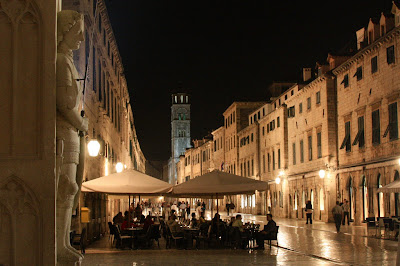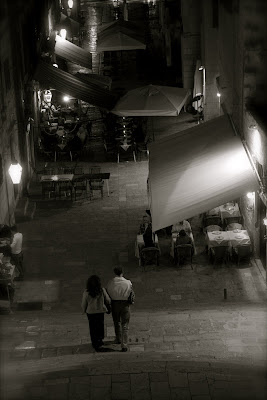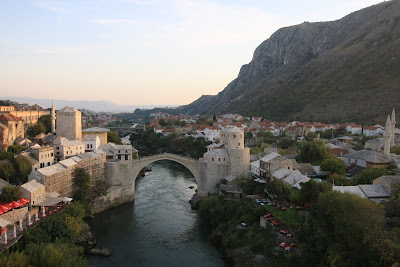
Today it was off to Bosnia. This was a day trip that intrigued us more than anything, unsure what we would find. We did our research to make sure it would be safe with the kids, and found nothing that would change our plans. What resulted was positively one of the most memorable days of our trip. Technically Bosnia is called “Bosnia and Herzegovina” (hert-sch-GOH-vee-nah), and we were in Mostar, which is the largest city in the Herzegovina region. Given all that, even if you live within the Herzegovina boundaries, you’re still considered a “Bosniak”. Mostar is a city with 3 faiths (Catholic Croats, Orthodox Serbs, Muslim Bosniaks), 3 languages, and 2 alphabets (latin and cryllic). For hundreds of years the people lived here in harmony; in fact Mostar used to have the most balanced population in all of former Yugoslavia. Since the Bosnian War though, everything and everyone has changed.
In 1992 Bosnia declared independence from Yugoslavia and shortly after the Serbs attacked, looking to acquire different parts of the country where their people had a majority. The already weak state administration ceased to exist and Bosnia quickly lost control. Bosnian Muslims, the only group loyal to the Bosnian government, were considered an easy target. Always living harmoniously in the past with the Croats, the two united against the attacking Serbs and eventually amassed enough strength to drive them out of Mostar. (To this day, Serbs are rare in Mostar.) Most of the refugees that fled during the attacks returned, and life was supposed to be back on track. But while all this was happening, some Croatian extremists decided it was the right time to take the area for themselves. So after the Serb forces were driven out, the heavily armed Croats started to attack the Bosniaks. Lines were quickly drawn, with the Croatian Army controlling the western part of the city, and the Bosniaks controlling the east. Our private tour guide Anela, who was a young girl at the time, remembers escaping to the hills during the Serb led attack, but was not as fortunate the second time around. The Croatian attack was unexpected, and she like many others did not have time to flee. She was forced to live in a bunker for the next couple of years and couldn't help but choke back tears as she tried to describe the situation. Nowhere was safe and we were told that corpses lay in the streets for months as it was too dangerous to retrieve them. The constant shelling reduced the entire city to rubble. The stronger Croatian forces engaged in mass execution and ethnic cleansing (ironically an atrocity happening to their own people within Croatia’s borders by the Serb Army) and mass graves are still being found today. When the dust settled in 1995, tens of thousands had lost their lives and Mostar was the most destroyed city in all of Yugoslavia.
Today there is still no trust amongst the people. The city government is equally divided between Croats and Bosniaks (it could exist no other way) and each side claims one side of Main Street. From there they have 2 of everything. (2 banking systems, 2 hospitals, 2 schools, 2 universities) Unemployment is said to be between 35-45% and rebuilding is slow. One factor in the rebuilding though has been the confusion in who owns what. Yugo Bank, which held all the mortgages, was another casualty of the war and no one is willing to invest in a property without clear ownership.
Anela worries that with ethnic passions in Mostar so high, a war could be on the horizon again. Add to that the fact that 49% of Bosnia is controlled by a political party called The Republic of Srpska (a Serb occupied and controlled territory) and things get even trickier. The Republic of Srpska’s boundaries run along the war lines established during the Bosnian War, and they have their own president, national anthem, and even post office. It’s a very confusing situation, even for the residents to understand. After recent threats from the Srpska president to follow the lead of other Yugoslavia countries and become independent, the Bosnian president responded by saying those who want to secede from Bosnia can pack up and leave, “but can’t take away an inch of Bosnian territory". The question becomes who will make the next move.
Even with so much damage on the surface, we found Mostar to be a beautiful city. The food, the people, and the overall feel left us craving more. Perhaps on our next trip to Europe we'll have to carve out more time for Bosnia.

The city’s most symbolic structure is the “Old Bridge”. It was originally built in 1566 but didn’t survive the war. While most of the city remains a mess, the symbolic bridge was a priority to be rebuilt. They used the same Mostar quarry for stone, hand-carved each block, and assembled them using technology learned by the ottomans 450 years earlier. When it reopened in 2004 it was said to be a symbolic step in reuniting the two sides.

The kids on the bridge with a not-so pretty background.

Signs on many of the damaged ruins warn you to keep out. One of the big dangers is undetonated explosives.

Throughout town, 33 mosques have been rebuilt, and 5 times a day the loudspeakers mounted to their tall minarets call Muslims to pray. It’s a very peaceful sound that blankets the entire city. When the Muslims come to pray they must wash before entering (a fountain stands in each courtyard), the men are separated from the women (so no one is distracted), and they always face Mecca. There are also no physical forms in the mosque, only symbols, as they must transcend the physical world to the spiritual one.

Here is one of the rebuilt minarets in front of a couple of buildings that have yet to be worked on.

Cole found some Turkish soldiers strolling the area.

Souvenir stands are full of old war paraphernalia.

Here's Anela modeling some traditional Turkish clothes. Turkish gifts filled the stores here, a unique twist from the same old souvenirs we see everywhere.

 We’re about to wrap up two months in Croatia, the last one spent here in Dubrovnik. We feel like Croatia experts now having traveled about 80% of the country. It’s been a great stay and there will be a lot about it we’ll miss. But it’s time to venture on and tomorrow we take the ferry back to Italy. Our first stop will be in the Puglia region so stay tuned for the next post. In the meantime, here’s one last look at Dubrovnik.
We’re about to wrap up two months in Croatia, the last one spent here in Dubrovnik. We feel like Croatia experts now having traveled about 80% of the country. It’s been a great stay and there will be a lot about it we’ll miss. But it’s time to venture on and tomorrow we take the ferry back to Italy. Our first stop will be in the Puglia region so stay tuned for the next post. In the meantime, here’s one last look at Dubrovnik. One of our favorite spots is the local market.
One of our favorite spots is the local market. Under the table on the porch...what better place to play a game.
Under the table on the porch...what better place to play a game. 


 With all the white stone, even night can feel like day.
With all the white stone, even night can feel like day.



 This little guy was very focused on the fisherman.
This little guy was very focused on the fisherman. 
 A cruise ship departing from just behind the wall.
A cruise ship departing from just behind the wall. ...Goodbye Dubrovnik!
...Goodbye Dubrovnik!
































 Cole watching them clean the newly harvested mussels.
Cole watching them clean the newly harvested mussels.












